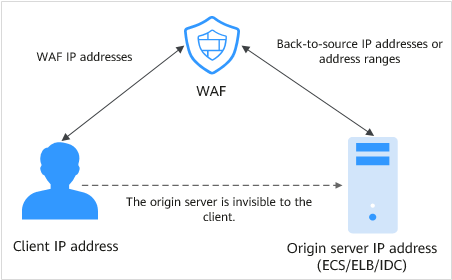What Is WAF?
Web Application Firewall (WAF) keeps web services stable and secure. It examines all HTTP and HTTPS requests to detect and block the following attacks: Structured Query Language (SQL) injection, cross-site scripting (XSS), web shells, command and code injections, file inclusion, sensitive file access, third-party vulnerability exploits, Challenge Collapsar (CC) attacks, malicious crawlers, and cross-site request forgery (CSRF).
After you enable a WAF instance, add your website domain to the WAF instance on the WAF console. All public network traffic for your website then goes to WAF first. WAF identifies and filters out the illegitimate traffic, and routes only the legitimate traffic to your origin server to ensure site security.
How WAF Works
After applying for WAF, add the website to WAF on the WAF console. After a website is connected to WAF, all website access requests are forwarded to WAF first. WAF detects and filters out malicious attack traffic, and returns normal traffic to the origin server to ensure that the origin server is secure, stable, and available.

The process of forwarding traffic from WAF to origin servers is called back-to-source. WAF uses back-to-source IP addresses to send client requests to the origin server. When a website is connected to WAF, the destination IP addresses to the client are the IP addresses of WAF, so that the origin server IP address is invisible to the client.

What WAF Protects
- Cloud mode: protects your cloud and on-premises web applications as long as they have domain names.
- Dedicated mode: domain names or IP addresses (public or private IP addresses) for web services on the cloud
Feedback
Was this page helpful?
Provide feedbackThank you very much for your feedback. We will continue working to improve the documentation.See the reply and handling status in My Cloud VOC.
For any further questions, feel free to contact us through the chatbot.
Chatbot





